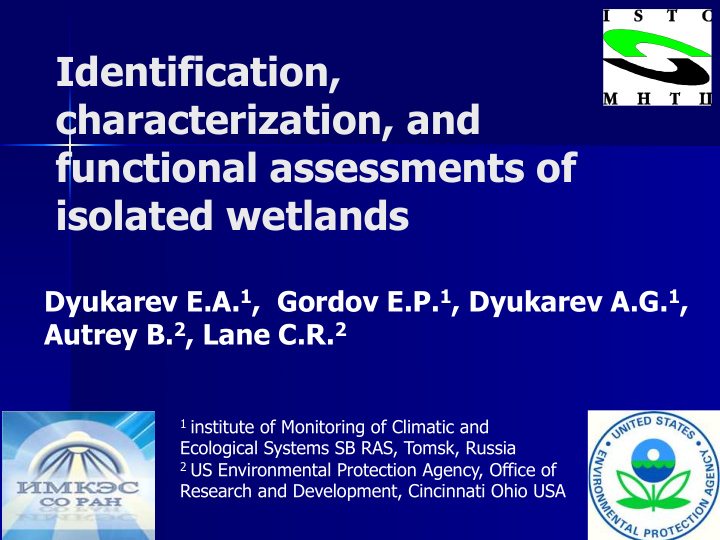



Identification, characterization, and functional assessments of isolated wetlands Dyukarev E.A. 1 , Gordov E.P. 1 , Dyukarev A.G. 1 , Autrey B. 2 , Lane C.R. 2 1 institute of Monitoring of Climatic and Ecological Systems SB RAS, Tomsk, Russia 2 US Environmental Protection Agency, Office of Research and Development, Cincinnati Ohio USA
ISTC project #4079 Identification, Characterization, and Functional Assessments of Isolated Wetlands of the Former Soviet Union n Institute of Monitoring of Climatic and Ecological Systems SB RAS, Tomsk n Institute of Chemical Biology and Fundamental Medicine SB RAS, Novosibirsk n Sukachev’ Institute of Forest SB RAS, Krasnoyarsk n US Environmental Protection Agency, Cincinnati, USA
Isolated wetland size n Small sized wetlands are difficult to delineate at satellite images. n Small wetlands are more vulnerable to external influence (climate change, water table lowering, pollution, antropogenic impact) than big stable peatlands with huge water and carbon storages.
Anthropogenic impact n Oil and acid pollution of soils during oil well exploitation n Accident oil pollution n Gas flares emission n Disturbances in hydrological regimes at linear industrial objects building n Increase of fire dangers at bog draining 4
Climate change Most intense warming in the continental areas Northern Hemisphere. n Changes in hydrological cycle due to changes in precipitations. n Ecosystem boundaries (Forest – Mire interface) is essentially changes under n climatic impact. 5 IPCC 2011
Landscape structure 1 – ancient river valley; 2 – denudation- accumulation plain; 3 – fluvial terrace, 4 – floodplain. Water wells line Depression in aquifer 177 water wells 250 000 m 3 water daily A. G. Dyukarev, N. N. Pologova State of Natural Environment in the Tomsk Water Intake Area // Contemporary Problems of Ecology, 2011, Vol. 4, No. 1
595 wetlands Total area – 25 636 ha 6,63 % 567 - isolated wetlands Total area – 9 714 ha 2,51 % 140 22% 22% N = 567; 120 Mean = 17,1; StdDv = 55, 2 ; Max = 769, 6 ; Min = 0,05 ha 100 16% 16% 50% 80 No of obs S < 6,4 ha 10% 10% 60 10% 10% 9% 9% 40 5% 5% 5%4%4% 5%4%4% 20 2%2%2%2%2% 2%2%2%2%2% 1%2%1%1%1%1%0%0%1%0%1% 1%2%1%1%1%1%0%0%1%0%1% 0 0 4 8 12 16 20 24 28 32 36 40 44 48 Wetland area, ha
Isolated wetland classification Bog Fen Dry
n Site “T” – “Timiryazevskoe” wetland n Site “K” – “Kirsanovskoe” D T wetland K n Site “D” – Dry peatland
Site “T” Site “K” n TR – pine-shrub-sphagnum n KR – pine-shrub-sphagnum community – oligotrophic bog community – oligotrophic bog n TF – open sedge-sphagnum fen n KF – open sedge-sphagnum fen
Site “D” n Dry peatland Peatland with low level of bog waters and compacted peat. Surface vegetation transformed. Fire dangerous area.
Site “T” Site “K” 2a Bog 2b Fen 1b Dry 1a n TR – pine-shrub-sphagnum n KR– pine-shrub-sphagnum community – oligotrophic bog. community – oligotrophic bog. 420 cm, C 14 age – 5880 yr. 310 cm, C 14 age – 5300 yr n TF – open sedge-sphagnum n KF – open sedge-sphagnum fen. 320 cm, C 14 age – 4000 yr fen. 100 cm, C 14 age – 3050 yr
Peat sampling
КТ КР ТТ ТР Peat stratigraphy 1990±80 1- сфагны , 2 Sph.fuscum, 3 – Sph. 3050±120 angustifolium, 4 – Sph. magellanicum, 1118±70 5- Sph. papilosum, 6- Sph. balticum, 7 1560±8 – Sph. majus, 8 - Sph. cuspidatum, 9 – 0 Sph. fallax, 10 – Sph. nemoreum, 11 1807±75 Sph. obtusum, 12-Sph. sect. Acutifolia, 13 - Scheuchzeria palustris, 14 - осоки , 15 – C. limosa, 16 – C. rostrata, 17 – C. lasiocarpa, 18- Menyanthes trifoliata, 19 – Equisetum, 20 – 5078±115 2374±85 Eriophorum vaginatum, 21 – Calla, 22 - 5290±120 4017±100 Pinus sylvestris, 23 - Oxicoccus KR TF palustris, 24 – злаки , 25 - Comarum palustre, 26 – травы , 27 – KF Phragmites australis, 28 - Theliptheris palustris, 29 – гипновые мхи , 30 – 3296±80 Drepanocladus, 31 – листовой опад , 32 – водоросли , 33 – кустарнички , 34 – Warnstorfia, 35 – древесина , 36 - Meesia triquetra, 37 - Pleurozium schreberi TR 5880±85
Site “T”. Peat depth map. n 240 depth sampling n Maximal depth – 8 m n Median depth – 2,7 m n Peat storages – 395 127 m 3
Carbon dioxide and methane emission H 2 O n Li-Cor LI - 8100A (Li- Cor Biogeoscience, CO 2 USA) Automated Soil CO2 Flux System with Transparent Long-Term Chamber LI-8100-104 CO 2 n Infra-red gas analyzer OPTOGAZ-500.4 (OPTEC, Russia). Static dark chamber method with n Air sampled from the chamber was analyzed by SHIMADZU GC-14b gas chromatograph at flame- ionization detector. Methane emission was CH 4 calculated from concentration rise within the chamber.
CO 2 and CH 4 emission measurement n Static dark chamber method n dt = 30 min n Twice per month n May – October n 2008 – 2012
Peatland vegetation Methane sampling photosynthesis measurements Li-Cor LI - 8100A Automated Soil CO2 Flux System 18
Seasonal variations of CO 2 emission Reconstruction from air temperature dependence F = a exp (b T) Q10 Dry = 1.69 Fen =1.70 Bog = 1.79
Carbon cycle scheme
Carbon turnover at studied peatlands KR KF TR TF
Спасибо за внимание ! Photo Charles R. Lane
Recommend
More recommend